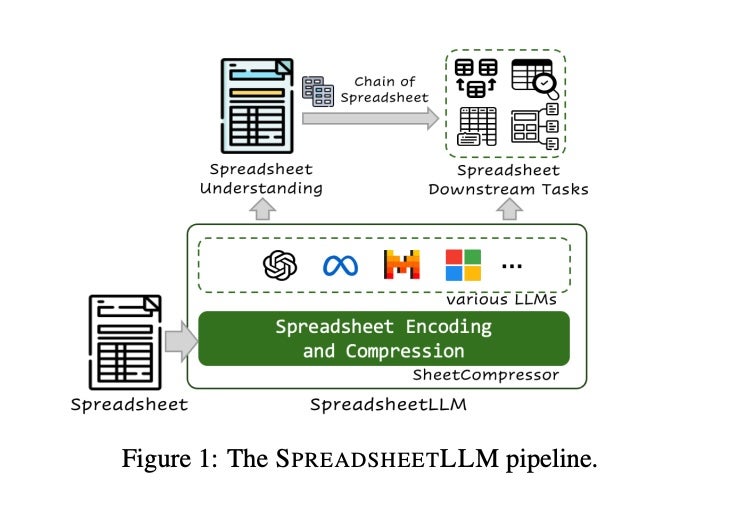Overview of SpreadsheetLLM by Microsoft Researchers
Introduction
Microsoft researchers have released a paper on Arxiv, presenting SpreadsheetLLM, an encoding framework enabling large language models (LLMs) to process spreadsheets. This innovative concept has the potential to transform spreadsheet data management and analysis, making it more efficient and intelligent. Key features of SpreadsheetLLM include simplified encoding, efficient processing, and the ability to extract specific cells for analysis.
The researchers believe that SpreadsheetLLM will pave the way for more productive user interactions, allowing users to engage with spreadsheets without requiring technical expertise. By using natural language queries to access spreadsheet data, users will be able to extract valuable insights and identify patterns without needing to learn technical spreadsheet formulas.
Why Are Spreadsheets a Challenge for Large Language Models?
Spreadsheets present a significant hurdle for LLMs due to several reasons. A key challenge is that spreadsheets contain a vast amount of data, frequently exceeding the number of characters that can be processed by an LLM at any given time. Additionally, spreadsheets have inherent structural complexities, as they possess two-dimensional layouts and structures, which cannot be easily understood by LLMs
- Spreadsheets can be extremely large and difficult to process in a single sequence.
- Traditional LLMs are not trained to parse and interpret cell addresses and specific spreadsheet formatting.
- Currently, LLMs are designed for sequential input and may struggle with large datasets.
Microsoft Researchers Used Multiple-Step Technique to Parse Spreadsheets
SpreadsheetLLM framework is composed of two main elements. The first part is SheetCompressor, a framework designed to shrink spreadsheets for easier processing by LLMs, accompanied by the Chain of Spreadsheet methodology which helps LLMs identify relevant segments within compressed spreadsheets and generate responses
- S SheetCompressor consists of three modules: structural anchors, a tokenizer, and a clustering algorithm – aimed at reducing the number of necessary tokens for LLM processing to 4% of the original value – effectively reducing the processing requirements in the 96% range
- The Chain of Spreadsheet method enables LLMs to create chains of related cells enabling LLMs to create longer sequences of connected cells providing deeper insights and understanding
What Does SpreadsheetLLM Mean for Microsoft’s AI Efforts?
The adoption of SpreadsheetLLM could lead to improved AI capabilities in Microsoft, leveraging generative AI for spreadsheet processes, potentially enhancing user experiences throughout Microsoft 365 applications
Moreover, the SpreadsheetLLM technology may provide another dimension for Microsoft’s AI assistant – Copilot – to perform tasks using spreadsheet data without the requirements for manual data entry
Real-World Usage and Next Steps for Microsoft Research
Data processing efficiency is essential with this technology, considering that additional energy consumption is associated with such methods. Moreover, LLM error-prone nature might cause issues where it attempts to generate information not actually being part of the spreadsheet. As they pointed out, it’s only when an LLM fully appreciates the format of a spreadsheet, knowing its typical structure and function, that there can be any chance of producing coherent
The technology team will focus on developing more robust versions that can process a bigger portion of the data more accurately including additional details such as background shading within cells, as well as allowing the LLMs to recognize stronger relationships between words within cells.
Conclusion
Microsoft’s SpreadsheetLLM stands out as a promising solution toward the automation of spreadsheet processing and data discovery, fostering a more intuitive interaction using LLMs. While early iterations may not provide major performance boosts, future enhancements seem promising, as the potential to explore spreadsheets more effectively widens the scope for LLM usability in various industries.
FAQs
- What is SpreadsheetLLM?
- Is this technology useful for businesses
- Are existing AI models capable of understanding spreadheets
The SpreadsheetLLM is an innovative framework created by Microsoft researchers, allowing for efficient processing and understanding of spreadsheet-based data by large language models.
Yes; it enables users to engage with spreadsheets using natural language queries, extracting valuable data while streamlining spreadsheet-based computations. Additionally, it could facilitate improvements to Microsoft’s AI assistant for various applications.










